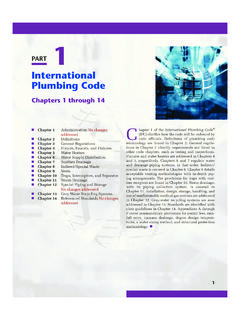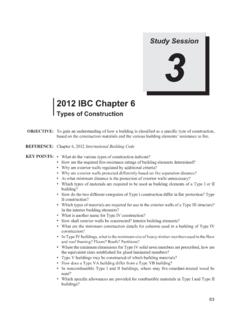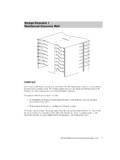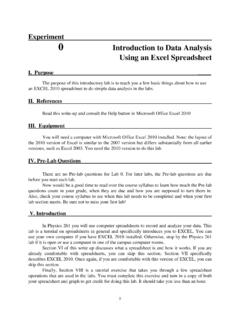Transcription of 2015 IRC Sections R303 through R310 - iccsafe.org
1 OBJECTIVE:REFERENCE:To develop an understanding of the health and safety criteria of the code, including light andventilation; minimum room areas and ceiling height; sanitation; toilet, bath, and showerspaces; glazing, including safety glazing; carports and garages; and emergency escape andrescue R303 through R310, 2015 International Residential Code Where natural light is used to satisfy the minimum illumination requirements, how is theminimum required amount of glazing determined? Where artificial light is used, whatillumination level is mandated? Under what conditions is a whole-house mechanical ventilation system required? How must mechanical and gravity outside air intake openings be located in relationship tovents, chimneys, parking lots and other potential areas of a hazardous or noxiouscontaminant?
2 Where must illumination be located in relationship to interior stairways? Exteriorstairways? In what climatic areas must a heating system be provided? What performance level ismandated for the system? What is the minimum required size of the largest habitable room in a dwelling unit? What is the minimum dimension permitted for a habitable room other than a kitchen? What is the minimum ceiling height permitted for a living room or bedroom? A hallway?Bathroom? Basement? Where can a reduction in such heights be acceptable? How much clear floor space is required in front of a water closet? In front of a showeropening? What is the minimum distance needed between the centerline of a water closetand the nearest adjoining obstruction such as a wall or shower compartment?
3 In what manner must safety glazing be identified? Multipane assemblies? What test standards are applicable to safety glazing materials? Which test standard isacceptable for glazing installed in any hazardous location?57 Study Session32015 IRC Sections R303 through R310 Building Planning IIKEY POINTS:(Cont d) What specific locations in and adjacent to doors are subject to human impact and requiresafety glazing? In tub and shower areas? In guards and railings? At stairways and stairwaylandings? When is sloped glazing considered a skylight? What glazing materials are permitted inskylights? When must a screen be installed below a skylight? How does a carport differ from a garage?
4 What limitations are placed on carports? Where are escape and rescue openings required? What is the minimum size of suchopenings? Maximum sill height? What limitations are placed on the operation of theopening? When a window well serves an escape and rescue opening, what is its minimum size? How may a bulkhead enclosure be utilized as an escape and rescue opening? Under what conditions may an emergency escape window be located under a deck orporch?582015 IRC Study CompanionTopic:Habitable RoomsCategory:Building PlanningReference:IRC :Light, Ventilation and HeatingStudy Session 359 Where the mechanical ventilation option is used for bathrooms and water-closet compartments, theminimum ventilation rates are set forth for either continuous ventilation or intermittent ventilation.
5 Inboth cases, the air must be exhausted directly to the exterior of the Text:Discussion andCommentary:All habitable rooms shall have an aggregate glazing area of not less than 8 percent of thefloor area of such rooms. Natural ventilation shall be through windows, skylights, doors,louvers or other approved openings to the outdoor air. The openable area to the outdoorsshall be not less than 4 percent of the floor area being allow the use ofartificial light and mechanical usable and sanitary interior environment depends on the inclusion of adequate light andventilation for the habitable spaces within the dwelling unit. Traditionally, the use of naturallight and, to some degree, natural ventilation has been mandated as the means for achievingsuch an environment.
6 It has become increasingly more common to use artificial lighting and amechanical ventilation system. These methods create additional design flexibility andfunctionality while maintaining a pleasant and sanitary living environment. ! " # Topic:Intake and Exhaust OpeningsCategory:Building PlanningReference:IRC , :Light, Ventilation and Heating602015 IRC Study CompanionOutdoor air exhaust and intake openings are regulated in the same manner as other openings inexterior walls. As such, they are not permitted in walls having a fire separation distance of less than 3feet, except in exterior walls that are perpendicular to the lot Text:Discussion andCommentary:Mechanical and gravity outdoor air intake openings shall be located not less than 10 feet(3048 mm)
7 From any hazardous or noxious contaminant, such as vents, chimneys, plumbingvents, streets, alleys, parking lots and loading docks, except as otherwise specified the exceptions, including #1, which allows for a lesser separation provided theintake opening is located at least 3 feet below the contaminant air shall notbe directed onto the context of this section, intake openings include windows, doors, combustion air intakesand similar openings that naturally or mechanically draw in air from the building alternative to the 10-foot separation requirement, a 3-foot vertical separation distance,will allow noxious gases and contaminants to disperse into the atmosphere before they can bedrawn into an air intake opening.
8 " $ % & ' ()*+ , $ * - * , ) $ " $ + . /+00 * - " $ " $ * , Topic:Stairway IlluminationCategory:Building PlanningReference:IRC , :Light, Ventilation and HeatingStudy Session 361 Code Text:Discussion andCommentary:Interior stairways shall be provided with an artificial light source to illuminate the landingsand the exception where remote, central or automatic control of lighting lighting outlets are installed in interior stairways, there shall be a wallswitch at each floor level to control the lighting outlet where the stairway has six or the exception for lights that are continuously illuminated or stairways shall be provided with an artificial light source located at thetop landing of the stairway is one of the most hazardous areas of a dwelling unit.
9 As such, the code highlyregulates the design and construction of all stairways. In addition, adequate lighting must beprovided to enable the stairway user to see the treads, their nosings and any obstructions thatmay be present. Stairway landings must also be adequately the light sources are on continuously or automatically activated, interior stairway lights mustbe controlled from both the top and bottom of each stairway consisting of six or more risers. Forexterior stairway lighting, the control switch is to be located within the dwelling .1 . 1 Topic:Minimum Areas and DimensionsCategory:Building PlanningReference:IRC R304 Subject:Minimum room Areas622015 IRC Study CompanionCode Text:Discussion andCommentary:Habitablerooms shall have a floor area of not less than 70 square feet ( m2).
10 Habitablerooms shall not be less than 7 feet (2134 mm) in any horizontal the exceptionsfor kitchens regarding minimum size and horizontal sizes for habitable rooms have been established. Because habitable rooms areexpected to be those spaces within a dwelling unit where most activities take place, they arethe only areas regulated. Most habitable rooms need be only 7 feet by 10 feet to comply withthe provisions; however, at least one larger room must be provided. It is seldom that anyhabitable room in today s typical dwelling unit would be designed with such a small minimum required floor area for any habitable room having a sloping ceiling, as would typicallybe encountered where an attic area is finished for use as a living or sleeping area, must be based ononly those portions of the room with a ceiling height of at least 5 SI: 1 degree = radTopic:Minimum HeightCategory:Building PlanningReference:IRC , :Ceiling HeightStudy Session 363 Code Text:Discussion andCommentary:Habitable space, hallways and portions of basements containing these spaces shall have aceiling height of not less than 7 feet (2134 mm).













